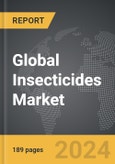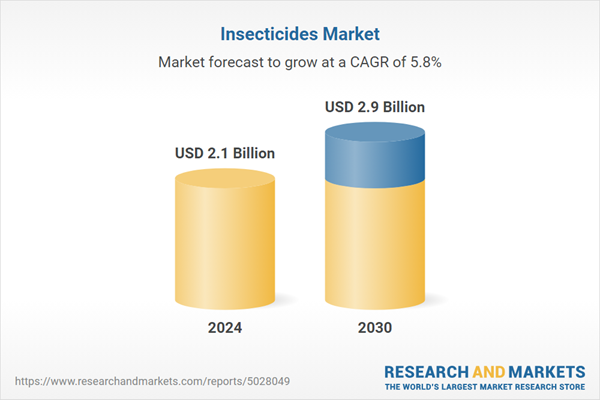The global market for Insecticides was valued at US$2.1 Billion in 2024 and is projected to reach US$2.9 Billion by 2030, growing at a CAGR of 5.8% from 2024 to 2030. This comprehensive report provides an in-depth analysis of market trends, drivers, and forecasts, helping you make informed business decisions. The report includes the most recent global tariff developments and how they impact the Insecticides market.
Segments: Type (Organophosphorus, Pyrethroids, Carbamates, Organochlorines, Botanicals, Other Types); Crop Type (Cereals & Grains, Oilseeds & Pulses, Fruits & Vegetables, Other Crop Types); Formulation (Emulsifiable Concentrates, Wettable Powder, Suspension Concentrates, Oil Emulsion in Water, Microencapsulated Suspension, Granules, Other Formulations).
Geographic Regions/Countries: World; United States; Canada; Japan; China; Europe (France; Germany; Italy; United Kingdom; Spain; Russia; and Rest of Europe); Asia-Pacific (Australia; India; South Korea; and Rest of Asia-Pacific); Latin America (Argentina; Brazil; Mexico; and Rest of Latin America); Middle East (Iran; Israel; Saudi Arabia; United Arab Emirates; and Rest of Middle East); and Africa.
The analysts continuously track trade developments worldwide, drawing insights from leading global economists and over 200 industry and policy institutions, including think tanks, trade organizations, and national economic advisory bodies. This intelligence is integrated into forecasting models to provide timely, data-driven analysis of emerging risks and opportunities.
Global Insecticides Market - Key Trends & Drivers Summarized
Why Is the Insecticides Market Crucial for Global Agriculture?
The global insecticides market plays a vital role in ensuring food security by protecting crops from a wide range of pests that can cause significant yield losses. Insecticides are essential tools for farmers, helping them to manage pest populations and maintain healthy crops. With the global population continuing to grow, the demand for agricultural products is increasing, putting additional pressure on farmers to maximize their yields. Insecticides are particularly important in regions where pest pressure is high and where other pest management strategies, such as crop rotation and biological control, may be less effective. The market is also influenced by the growing need for food production to be efficient, cost-effective, and environmentally sustainable. This has led to the development and adoption of more targeted and less environmentally damaging insecticides, which are better aligned with the principles of integrated pest management (IPM).How Are Technological Innovations Shaping the Insecticides Market?
Technological innovations are driving significant changes in the insecticides market, enhancing the effectiveness and environmental profile of these products. Advances in formulation technology have led to the development of new insecticides that are more potent against target pests while being less harmful to non-target organisms and the environment. The integration of digital farming tools and precision agriculture is also transforming the way insecticides are applied, allowing for more precise targeting of pest populations, which reduces waste and minimizes the environmental impact. Additionally, the ongoing research into novel modes of action and the development of bioinsecticides, which use natural organisms or substances to control pests, are creating new opportunities in the market. These innovations are not only improving the performance of insecticides but are also addressing growing concerns over pest resistance and the need for more sustainable agricultural practices.What Role Does Regulatory Pressure and Consumer Demand Play in Shaping the Market?
Regulatory pressure and changing consumer preferences are significant factors shaping the insecticides market. Governments around the world are implementing stricter regulations on the use of chemical pesticides, driven by concerns over their environmental and health impacts. These regulations are encouraging the development and adoption of safer, more sustainable insecticides, including biopesticides and other alternatives to traditional chemicals. At the same time, consumers are increasingly demanding food that is produced with minimal chemical inputs, driving farmers to adopt pest management strategies that reduce reliance on synthetic insecticides. This shift in consumer behavior is also leading to greater transparency and traceability in the supply chain, with more emphasis on sustainable and environmentally friendly farming practices. As a result, the insecticides market is evolving to meet these demands, with a growing emphasis on products that are effective, safe, and environmentally responsible.What Are the Key Drivers Fueling the Growth of the Insecticides Market?
The growth in the insecticides market is driven by several key factors, including the increasing global demand for food, the need for effective pest control solutions, and the push for more sustainable agricultural practices. As the global population grows, so does the need to protect crops from pests that can significantly reduce yields. This has led to a sustained demand for insecticides, particularly in regions with high pest pressure. Technological advancements in formulation and application are also driving market growth, as they enable more targeted and efficient use of insecticides, reducing environmental impact while maintaining effectiveness. Additionally, the regulatory environment is shaping the market, with stricter controls on chemical pesticides leading to the development and adoption of safer alternatives. The growing consumer demand for sustainably produced food is further pushing the market towards more environmentally friendly products. As these trends continue to evolve, the insecticides market is expected to see continued growth, driven by the need for effective, sustainable, and safe pest management solutions.Report Scope
The report analyzes the Insecticides market, presented in terms of units. The analysis covers the key segments and geographic regions outlined below.Segments: Type (Organophosphorus, Pyrethroids, Carbamates, Organochlorines, Botanicals, Other Types); Crop Type (Cereals & Grains, Oilseeds & Pulses, Fruits & Vegetables, Other Crop Types); Formulation (Emulsifiable Concentrates, Wettable Powder, Suspension Concentrates, Oil Emulsion in Water, Microencapsulated Suspension, Granules, Other Formulations).
Geographic Regions/Countries: World; United States; Canada; Japan; China; Europe (France; Germany; Italy; United Kingdom; Spain; Russia; and Rest of Europe); Asia-Pacific (Australia; India; South Korea; and Rest of Asia-Pacific); Latin America (Argentina; Brazil; Mexico; and Rest of Latin America); Middle East (Iran; Israel; Saudi Arabia; United Arab Emirates; and Rest of Middle East); and Africa.
Key Insights:
- Market Growth: Understand the significant growth trajectory of the Organophosphorus segment, which is expected to reach US$852.0 Million by 2030 with a CAGR of a 5.8%. The Pyrethroids segment is also set to grow at 6.4% CAGR over the analysis period.
- Regional Analysis: Gain insights into the U.S. market, valued at $544.8 Million in 2024, and China, forecasted to grow at an impressive 9.2% CAGR to reach $648.1 Million by 2030. Discover growth trends in other key regions, including Japan, Canada, Germany, and the Asia-Pacific.
Why You Should Buy This Report:
- Detailed Market Analysis: Access a thorough analysis of the Global Insecticides Market, covering all major geographic regions and market segments.
- Competitive Insights: Get an overview of the competitive landscape, including the market presence of major players across different geographies.
- Future Trends and Drivers: Understand the key trends and drivers shaping the future of the Global Insecticides Market.
- Actionable Insights: Benefit from actionable insights that can help you identify new revenue opportunities and make strategic business decisions.
Key Questions Answered:
- How is the Global Insecticides Market expected to evolve by 2030?
- What are the main drivers and restraints affecting the market?
- Which market segments will grow the most over the forecast period?
- How will market shares for different regions and segments change by 2030?
- Who are the leading players in the market, and what are their prospects?
Report Features:
- Comprehensive Market Data: Independent analysis of annual sales and market forecasts in US$ Million from 2024 to 2030.
- In-Depth Regional Analysis: Detailed insights into key markets, including the U.S., China, Japan, Canada, Europe, Asia-Pacific, Latin America, Middle East, and Africa.
- Company Profiles: Coverage of players such as ABC Compounding Co., Inc., ADAMA Agricultural Solutions Limited, AgroSpheres, American Vanguard Corporation, Babolna Bio and more.
- Complimentary Updates: Receive free report updates for one year to keep you informed of the latest market developments.
Some of the 32 companies featured in this Insecticides market report include:
- ABC Compounding Co., Inc.
- ADAMA Agricultural Solutions Limited
- AgroSpheres
- American Vanguard Corporation
- Babolna Bio
- BASF SE
- Bayer AG
- Bayer AG - Crop Science Division
- Bhagiradha Chemicals & Industr
- Brody Chemical
Tariff Impact Analysis: Key Insights for 2025
Global tariff negotiations across 180+ countries are reshaping supply chains, costs, and competitiveness. This report reflects the latest developments as of April 2025 and incorporates forward-looking insights into the market outlook.The analysts continuously track trade developments worldwide, drawing insights from leading global economists and over 200 industry and policy institutions, including think tanks, trade organizations, and national economic advisory bodies. This intelligence is integrated into forecasting models to provide timely, data-driven analysis of emerging risks and opportunities.
What’s Included in This Edition:
- Tariff-adjusted market forecasts by region and segment
- Analysis of cost and supply chain implications by sourcing and trade exposure
- Strategic insights into geographic shifts
Buyers receive a free July 2025 update with:
- Finalized tariff impacts and new trade agreement effects
- Updated projections reflecting global sourcing and cost shifts
- Expanded country-specific coverage across the industry
Table of Contents
I. METHODOLOGYII. EXECUTIVE SUMMARY2. FOCUS ON SELECT PLAYERSIII. MARKET ANALYSISCANADAITALYSPAINRUSSIAREST OF EUROPESOUTH KOREAREST OF ASIA-PACIFICARGENTINABRAZILMEXICOREST OF LATIN AMERICAIRANISRAELSAUDI ARABIAUNITED ARAB EMIRATESREST OF MIDDLE EASTIV. COMPETITION
1. MARKET OVERVIEW
3. MARKET TRENDS & DRIVERS
4. GLOBAL MARKET PERSPECTIVE
UNITED STATES
JAPAN
CHINA
EUROPE
FRANCE
GERMANY
UNITED KINGDOM
ASIA-PACIFIC
AUSTRALIA
INDIA
LATIN AMERICA
MIDDLE EAST
AFRICA
Companies Mentioned (Partial List)
A selection of companies mentioned in this report includes, but is not limited to:
- ABC Compounding Co., Inc.
- ADAMA Agricultural Solutions Limited
- AgroSpheres
- American Vanguard Corporation
- Babolna Bio
- BASF SE
- Bayer AG
- Bayer AG - Crop Science Division
- Bhagiradha Chemicals & Industr
- Brody Chemical
Table Information
| Report Attribute | Details |
|---|---|
| No. of Pages | 189 |
| Published | April 2025 |
| Forecast Period | 2024 - 2030 |
| Estimated Market Value ( USD | $ 2.1 Billion |
| Forecasted Market Value ( USD | $ 2.9 Billion |
| Compound Annual Growth Rate | 5.8% |
| Regions Covered | Global |









